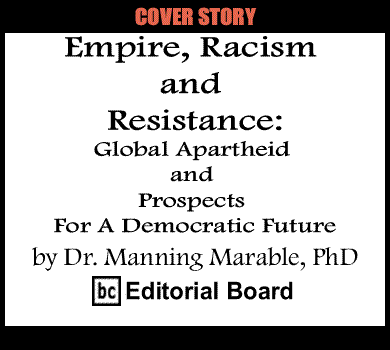
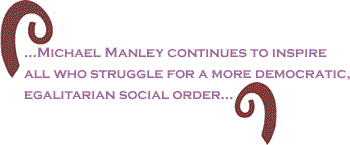
The following is a speech given at the Fifth Annual Michael Manley Lecture sponsored by the Michael Manley Foundation, Sagicor Life of Jamaica Auditorium, Kingston, Jamaica, Sunday, 10 December 2006.
I am deeply honored to have been invited to address you this afternoon, on behalf of the Michael Manley Foundation. I personally knew and spent time with former Prime Minister Michael Manley, and I came to understand why he became beloved by so many millions of people throughout the world. As a champion of the poor and dispossessed, as a visionary spokesman for the politics of social justice, Michael Manley continues to inspire all who struggle for a more democratic, egalitarian social order.
Although Michael Manley’s commitment to democratic socialism began in the years after the Second World War, when he studied with Harold Laski at the London School of Economics, his real passion for the disposed and the disadvantaged really took root during the years he spent as a union organizer of Jamaica’s National Workers Union (NWU). During the 1950s and 1960s, Manley learned first-hand the trials and tribulations of ordinary working people, and he deeply identified with their plight. An important turning point in his development occurred in 1964, when Manley led NWU workers in a famous, 97-day strike against the state television company. Through the many marches and public protests Manley personally led, he rallied workers with the cry to “bring down the walls of Jericho,” and workers responded by calling Michael “Joshua.” Less than a decade later, as leader of the People’s National Party, “Joshua” would lead his party to victory.
During the 1970s, few Third World leaders personified the aspirations of nonaligned nations better than Michael Manley. Along with Tanzania’s Julius Nyerere, Manley preached “self reliance” and “self sufficiency”, themes that resonated favorably with Jamaica’s rural peasantry. Manley called for both a “South-South” dialogue, building practical coalitions between and among Third World nations in Asia, Africa, Latin America, and the Caribbean, as well as a new “North-South” dialogue between Europe and North America with the developing world. Manley identified “democratic socialism” with “love,” and envisioned a Jamaican society where all members could become meaningful participants.

My lecture this afternoon, “Empire, Racism, and Resistance,” broadly examines the impact of globalization, and neoliberal economics, on the evolving politics of race, within the United States as well as transnationally. More specifically, the lecture addresses four interrelated themes, or issues of concern:
(1) an analysis of the emergence of what other scholars and writers have termed “global apartheid,” and what I describe as the “New Racial Domain” of “color-blind racism” inside the United States, which represents a new mode of racial oppression;
(2) the central role of “Neoliberalism,” and the conservative politics of Thatcherism and Reaganism during the 1980s, in the transnational acceleration of racial and class stratification and wealth inequality, within nations and throughout the world;
(3) the impact and consequences of the terrorist attacks of 9/11 within the U.S., in reinforcing the “New Racial Domain,” within the United States, and a “global apartheid” within the Third World;
(4) and an analysis of the prospects for transnational racial and class resistance to both global apartheid and America’s “New Racial Domain.”
In 1900, the great African-American scholar W.E.B. Du Bois, predicted that the “problem of the twentieth century” would be the “problem of the color line,” the unequal relationship between the lighter versus darker races of humankind. Although Du Bois was primarily focused on the racial contradiction of the United States, he was fully aware that the processes of what we call “racialization” today – the construction of racially unequal social hierarchies characterized by dominant and subordinate social relations between groups – was an international and global problem. Du Bois’s color line included not just the racially segregated, Jim Crow South and the racial oppression of South Africa; but also included British, French, Belgian, and Portuguese colonial domination in Asia, the Middle East, Latin America, and the Caribbean among indigenous populations.
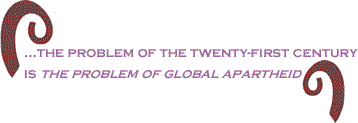
Building on Du Bois’s insights, we can therefore say that the problem of the twenty-first century is the problem of global apartheid: the racialized division and stratification of resources, wealth, and power that separates Europe, North America, and Japan from the billions of mostly black, brown, indigenous, undocumented immigrant and poor people across the planet. The term apartheid, as most of you know, comes from the former white minority regime of South Africa. It is an Afrikaans word meaning “apartness” or “separation.” Apartheid was based on the concept of “herrenvolk,” a “master race,” who was destined to rule non-Europeans. Under global apartheid today, the racist logic of herrenvolk, the master race, still exists, embedded in the patterns of unequal economic exchange that penalizes African, south Asian, Caribbean, and poor nations by predatory policies of structural adjustment and loan payments to multinational banks.
Since 1979-1980, with the elections of Ronald Reagan as U.S. president and Margaret Thatcher as Prime Minister of the United Kingdom, America and Britain have embarked on domestic economic development strategies that have come to be known by the term, “neoliberalism.” “Neoliberalism” called for the dismantling of the welfare state; the end of redistributive social programs designed to address the effects of poverty; the elimination of state regulations and regulatory agencies over the market; and “privatization,” policies designed to transfer public institutions and government-sponsored agencies to private enterprise.
In a recent issue of the New York Times (December 5, 2006), Professor Thomas B. Edsall of Columbia University’s Graduate School of Journalism astutely characterized this reactionary process of neoliberal politics within the United States in these terms: “For a quarter-century, the Republican temper – its reckless drive to jettison the social safety net; its support of violence in law enforcement and national defense; its advocacy of regressive taxation, environmental hazard and probusiness deregulation; its ‘remoralizing’ of the pursuit of wealth – has been judged by many voters as essential to America’s position in the world, producing more benefit than cost.”
One of the consequences of this reactionary political and economic agenda, according to Edsall, was “the Reagan administration’s arms race” during the 1980s, which “arguably drove the Soviet Union into bankruptcy.” A second consequence, Edsall argues, was America’s disastrous military invasion of Iraq. “While inflicting destruction on the Iraqis,” Edsall observes, “Bush multiplied America’s enemies and endangered this nation’s military, economic health and international stature. Courting risk without managing it, Bush repeatedly and remorselessly failed to accurately evaluate the consequences of his actions.”
What is significant about Edsall’s analysis is that he does not explain away the 2003 U.S. invasion of Iraq and current military occupation as a political “mistake” or an “error of judgment.” Rather, he locates the rationale for the so-called “war on terrorism” within the context of U.S. domestic, neoliberal politics. “The embroilment in Iraq is not an aberration,” Edsall observed. “It stems from core [Republican] party principles, equally evident on the domestic front.”
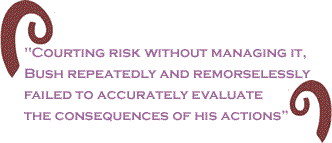
The larger question of political economy, left unexplored by Edsall and most African analysts, is the connection between American militarism abroad, neoliberalism, and trends in the global economy. As economists Paul Sweezy, Harry Magdoff and others noted decades ago, the general economic tendency of mature capitalism is toward stagnation. For decades in the United States and western Europe, there has been a steady decline in investment in the productive economy, leading to a decline in industrial capacity and lower future growth.
Since capitalist economies are “based on the profit motive and accumulation of capital without end,” in the words of writer Fred Magdoff, “problems arise whenever they do not expand at reasonably high growth rates.” Since the 1970s, U.S. corporations and financial institutions have relied primarily on debt to expand domestic economic growth. By 1985, total U.S. debt – which is comprised of the debt owed by all households, governments (federal, state and local), and all financial and non-financial businesses, reached twice the size of the annual U.S. gross domestic product. By 2005, the total U.S. debt amounted to nearly “three and a half times the nation’s GDP, and not far from the $44 trillion GDP for the entire world,” according to Fred Magdoff.
As a result, mature U.S. corporations have been forced to export products and investment abroad, to take advantage of lower wages, weak or nonexistent environmental and safety standards, and so forth, to obtain higher profit margins. Today about 18 percent of total U.S. corporate profits come from direct overseas investment. Partially to protect these growing investments, the United States has pursued an aggressive, interventionist foreign policy across the globe. As of 2006, the U.S. maintained military bases in fifty-nine nations. The potential for deploying military forces in any part of the world is essential for both political and economic hegemony.
Thus the current Iraq War was not essentially a military blunder caused by a search for “weapons of mass destruction,” but an imperialist effort to secure control of the world’s second largest proven oil reserves; it was also the first military step of the Bush administration’s neoconservatives (such as Paul Wolfewitz, now head of the World Bank) to “remake the Middle East” by destroying the governments of Iraq, Iran and Syria.
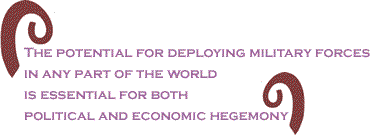
Although the majority of nations in the international community either openly oppose, or at least seriously question, the U.S. military occupation of Iraq, the neoliberal economic model of the United States has now widely been adopted by both developed and developing countries. Governments across the ideological spectrum – with the exception of many Latin American countries in recent years – have eliminated social welfare, health and education programs, reduced regulations on business activity, and encouraged the growth of income inequality and entrepreneurship. As a result, economic inequality in wealth has rapidly accelerated.
A 2006 study by the World Institute for Development Economic Research of the United Nations University, establishes that as of 2000, the upper 1 percent of the globe’s adult population, approximately 37 million people, who average about $515,000 in net worth per person, collectively control roughly 40 percent of the world’s entire wealth. By contrast, the bottom one-half of the planet’s adult population, 1.85 billion people, most of whom are black and brown, own only 1.1 percent of the world’s total wealth. There is tremendous inequality of wealth between nations, the U.N. report notes. The United States, for example, comprises only 4.7 percent of the world’s people, but it has nearly one-third, or 32.6 percent, of global wealth. By stark contrast, China, which has one-fifth of the world’s population, owns only 2.6 percent of the globe’s wealth. India, which has 16.8 percent of the global population, controls only 0.9 percent of the world’s total wealth.
Within most of the world’s countries, wealth is disproportionately concentrated in the top ten percent of each nation’s population. It comes as no surprise that in the United States, for example, the upper 10 percent of the adult population owns 69.8 percent of the nation’s total wealth. Canada, a nation with more liberal social welfare traditions than the U.S., nevertheless still exhibits significant inequality. More than one-half of Canadian assets, 53 percent, are owned by only ten percent of the population. European countries such as Norway, at 50.5 percent, and Spain, at 41.9 percent, have similar or slightly lower levels of wealth inequality.
The most revealing finding of the World Institute for Development Economics Research is that similar patterns of wealth inequality now exist throughout the Third World. In Indonesia, for example, 65.4 percent of the nation’s total wealth belongs to the wealthiest 10 percent. In India, the upper ten percent owns 52 percent of all Indian wealth. Even in China, where the ruling Communist Party still maintains vestiges of what might be described as “authoritarian state socialism,” the wealthiest 10 percent own 41.4 percent of the national wealth.

But even these macroeconomic statistics, as useful as they are, obscure a crucial dimension of wealth concentration, under global apartheid’s neoliberal economics. In the past 20 years in the United States, where deregulation and privatization has been carried to extremes, we are witnessing a phenomenon that the media has described as “the very rich” who are leaving “the merely rich behind.” A recent study by New York University economist Edward N. Wolff has found that one out of every 825 households in the U.S. in 2004 earned at least $2 million annually, representing nearly a 100 percent increase in the wealth percentage recorded in 1989, adjusted for inflation. As of 2004, one out of every 325 U.S. households possessed a net wealth of $10 million or more. When adjusted by inflation, this is more than four times as many wealthy households as in 1989. The exponential growth of America’s “super-rich” is a direct product of the near-elimination of capital gains taxes, and the sharp decline in federal government income tax rates.
We still tend to perceive the political world in eighteenth and nineteenth century terms: as competing “nations,” geopolitical units defined by territorial boundaries, which conduct international affairs based on their perceived objective interests. In the twenty-first century, however, we must perceive of our political world entirely differently: as an environment in which multinational corporations exert greater power and influence than many countries; where millions of low-wage, manufacturing jobs each year are being relocated to south Asia, China, and Latin America. Globalization, and the widespread adoption of the neoliberal economic model of development, are constructing an affluent, transnational “ruling class,” a privileged stratum whose class interests largely supercede its national allegiances.
Inside the United States, the processes of global apartheid are best represented by what I call the “New Racial Domain,” or the NRD. This New Racial Domain is different from other earlier forms of racial domination, such as slavery, Jim Crow segregation, and ghettoization, or strict residential segregation, in several critical aspects. These earlier racial formations or domains were grounded or based primarily, if not exclusively, in the political economy of U.S. capitalism. Anti-racist or oppositional movements that blacks, other people of color and white anti-racists built were largely predicated upon the confines or realities of domestic markets and the policies of the U.S. nation-state. Meaningful social reforms such as the Civil Rights Act of 1964 and the Voting Rights Act of 1965 were debated almost entirely within the context of America’s expanding, domestic economy, and influenced by Keynesian, welfare state public policies.
The political economy of America’s “New Racial Domain,” by contrast, is driven and largely determined by the forces of transnational capitalism, and the public policies of state neoliberalism. From the vantage point of the most oppressed U.S. populations, the New Racial Domain rests on an unholy trinity, or deadly triad, of structural barriers to a decent life. These oppressive structures are mass unemployment, mass incarceration, and mass disfranchisement. Each factor directly feeds and accelerates the others, creating an ever-widening circle of social disadvantage, poverty, and civil death, touching the lives of tens of millions of U.S. people.

The process begins at the point of production. A recent study by Northeastern University’s Center for Labor Market Studies establishes that in 2002, one of every four African-American adult males was unemployed throughout the entire year of 2002. The black male jobless rate was over twice that for white and Latino males. Even these statistics seriously underestimate the real problem, because they don’t factor in the huge number of African-American males in prison or those who are homeless.
For black males without a high school level education, their job prospects are even worse. The Center’s study notes that among black male high school dropouts, 44 percent were unemployed for the entire year of 2002. For black men between the ages of 55 to 64 years, jobless rates for 2002 were almost 42 percent. New York Times columnist Bob Herbert has described these dire statistics as evidence of “an emerging catastrophe – levels of male joblessness that mock the very idea of stable, viable communities. This slow death of the hopes, pride, and well-being of huge numbers of African Americans is going unnoticed by most other Americans and by political leaders of both parties.”
So long as African Americans were the chief casualties in the ranks of those who were permanently unemployed, white elected officials could afford to ignore the crisis. But now, increasingly, millions of white workers who have considered themselves “middle class” are being pushed into the ranks of the jobless. In late July 2004, the Labor Department’s Bureau of Labor Statistics noted that between 2001 and 2003, 8.7 percent of all jobholders in the U.S. were permanently dismissed from their jobs. This figure amounts to 11.4 million men and women age 20 or older. This was, according to the Bureau, the “second fastest rate” of layoffs “on record since 1980.” Among laid-off workers who found new jobs, 56.9 percent were earning less money than from their former employment.
Mass unemployment inevitably feeds mass incarceration. About one-third of all prisoners were unemployed at the time of their arrests, and others averaged less than $20,000 annual incomes in the year prior to their incarceration. When the Attica prison insurrection occurred in upstate New York in 1971, there were only 12,500 prisoners in New York State’s correctional facilities, and about 300,000 prisoners nationwide. By 2001, New York State held over 71,0000 women and men in its prisons; nationally, 2.1 million were imprisoned. Today about six million Americans are arrested annually, and roughly one in five Americans possess a criminal record.
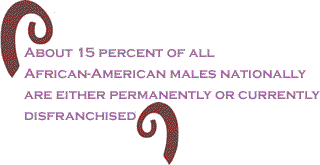
Mandatory-minimum sentencing laws adopted in the 1980s and 1990s in many states stripped judges of their discretionary powers in sentencing, imposing Draconian terms on first-time and non-violent offenders. Parole has been made more restrictive as well, and in 1995 Pell grant subsidies supporting educational programs for prisoners were ended. For those fortunate enough to successfully navigate the criminal justice bureaucracy and emerge from incarceration, they discover that both the federal law and state governments explicitly prohibit the employment of convicted ex-felons in hundreds of vocations. The cycle of unemployment frequently starts again.
Mass incarceration, of course, breeds mass political disfranchisement. Nearly six million Americans today cannot vote. In seven states, former prisoners convicted of a felony lose their voting rights for life. In the majority of states, individuals on parole and probation cannot vote. About 15 percent of all African-American males nationally are either permanently or currently disfranchised. In Mississippi, one-third of all black men are unable to vote for the remainder of their lives. In Florida, 818,000 residents cannot vote for life.
Even temporary disfranchisement fosters a disruption of civic engagement and involvement in public affairs. This can lead to “civil death,” the destruction of the capacity for collective agency and resistance. This process of depolitization undermines even grassroots, non-electoral-oriented organizing. The deadly triangle of the New Racial Domain constantly and continuously grows unchecked.
Not too far in the distance lies the social consequence of these policies inside the United States: an unequal, two-tiered, uncivil society, characterized by a governing hierarchy of middle- to upper-class “citizens” who own nearly all private property and financial assets, and a vast subaltern of quasi- or subcitizens encumbered beneath the cruel weight of permanent unemployment, discriminatory courts and sentencing procedures, dehumanized prisons, voting disfranchisement, residential segregation, and the elimination of most public services for the poor. The latter group is virtually excluded from any influence in a national public policy. Institutions that once provided space for upward mobility and resistance for working people such as unions have been largely dismantled. Integral to all of this is racism, sometimes openly vicious and unambiguous, but much more frequently presented in race neutral, color-blind language. This is the NRD of domestic apartheid in America.

The terrorist attacks of 11 September 2001, and their political aftermath, have also been pivotal factors in reinforcing global apartheid and the “New Racial Domain” inside the United States. As in previous times of war in the U.S., the vast majority of Americans, regardless of political party affiliation, immediately rallied behind the president after 9/11, demanding military retribution against the Al Qaeda Islamic terrorists. President Bush characterized the “evil-doers” as both “pathological” and “insane,” and for days following the attacks the administration promised to launch a global “crusade” against Islamic terrorism. To the world’s over one billion Muslims, and to the six million Muslims living within the U.S., the term “crusade” instantly evoked disturbing historical images of the Christian invasions of the Islamic Middle East during the Middle Ages. The Bush administration soon quietly discarded its “crusader” rhetoric, but continued to indirectly promote anti-Islamic and anti-Arab sentiment to mobilize the nation for its “War Against Terrorism.” U.S. military soon invaded and occupied Afghanistan, the nation in which Al Qaeda had established its base of operations under the fundamentalist Taliban regime. Then, in early 2003, U.S. military forces subsequently invaded Iraq, which was accused of harboring Al Qaeda terrorists and possessing “weapons of mass destruction” that represented a threat to U.S. national security.
Like other Americans, African Americans were morally and politically outraged by Al Qaeda’s terrorist attacks. Yet they were deeply troubled by the immediate groundswell of ultra-patriotic fervor, national chauvinism and numerous acts of violence and harassment targeting individual Muslims and Arab Americans. They recognized that behind this mass upsurgence of American patriotism was xenophobia, ethnic and religious intolerance, that could potentially reinforce traditional white racism against all people of color, particularly themselves. They questioned the Bush administration’s “Patriot Act of 2001” and other legal measures that severely restricted Americans’ civil liberties and privacy rights. For these reasons, many black leaders sought to uphold civil rights and civic liberties, and challenged the U.S. rationale for its military incursions in both Afghanistan, and later Iraq. The pastor of New York City’s Riverside Church, the Reverend James A. Forbes, Jr., proposed that African Americans embrace a critical, “prophetic patriotism. . . . You will hold America to the values of freedom, justice, compassion, equality, respect for all, patience and care for the needy, a world where everyone counts.” Urban League President Hugh Price argued that black Americans must “vigorously support the federal government’s efforts to root out the terrorists wherever they hide around the globe . . .” However, Price also insisted that “black America’s mission, as it has always been, is to fight against the forces of hatred and injustice, to fight for the right of all human beings to life, liberty and the pursuit of happiness.”
As the U.S. Justice Department began to arrest and hold without trial hundreds of Muslims and Arab Americans, Islamic groups urgently appealed to the NOI, NAACP and the Congressional Black Caucus for assistance. Approximately 40 percent of the U.S.’s Islamic population is African American, and hundreds of native-born blacks, because of their religious affiliations, also found themselves under surveillance or were arrested, despite having no links to terrorist groups. The Reverend Jesse Jackson openly condemned the police practice of ethnic/religious “profiling,” declaring that the U.S. needed to focus its resources toward the “building of understanding and building a just peace,” instead of resorting to warfare to “root out terrorism.” In March, 2003, when the U.S. military invaded Iraq, a Pew Research Center opinion poll found that only 44 percent of African Americans favored the war. By contrast, white Americans endorsed the invasion by 73 percent, with Latinos favoring military conflict by 66 percent. African-American clergy, led by Brooklyn activist, the Reverend Herbert Daughtry, organized daily “vigils for peace” near the United Nations. The black ministers created a “Martin Luther King, Jr. Peace Now Movement,” which actively participated in the growing anti-war mobilization throughout the U.S.
By early April 2003, the U.S. had successfully toppled the regime of dictator Saddam Hussein, and over one hundred thousand U.S. troops occupied the country. However, the military invasion of an Islamic country strengthened the network of fundamentalist Islamic terrorists, by creating a vivid example of imperialist aggression aimed against the entire Islamic world. In an April 4, 2003, Gallup opinion poll, 78 percent of white Americans supported the military invasion; African-American support for the war had plummeted to only 29 percent.
By early 2004, the Bush administration had begun to aggressively pressure universities to suppress dissent, and to curtail traditional, academic freedoms. In early March 2004, the U.S. Treasury Department’s Office of Foreign Assets Control stopped 70 American scientists and physicians from traveling to Cuba to attend an international symposium on “coma and death.” Some of the scholars received warning letters from the Treasury Department, promising severe criminal or civil penalties if they violated the embargo against Cuba. In late 2003, the Treasury Department issued a warning to U.S. publishers that they would have to obtain “special licenses to edit papers” written by scholars and scientific researchers currently living in Cuba, Libya, Iran, or Sudan. All violators, even including the editors and officers of professional associations sponsoring scholarly journals, potentially may be subjected to fines up to $500,000 and prison sentences up to ten years. After widespread criticism, the Treasury Department was forced to moderate its policy.
The long-term catastrophe of the terrorist attacks of November 11, 2001, from the perspective of the Black Freedom Movement, have been two-fold. The U.S. military invasions of Afghanistan and Iraq had greatly eroded domestic civil liberties and civil rights, creating a mass environment of ethnic/religious hostility, permitting indiscriminate police surveillance, racial profiling and arrests. Tens of thousands of young African Americans in the armed forces were stationed in war zones, for a conflict that most blacks strongly opposed. Second, in terms of racial policy, the intense national debate over “black reparations” that had dominated headlines throughout 2001 was derailed, perhaps for decades to come, beneath the tidal waves of ultra-patriotism and American xenophobia. The racial reality was that American state power had partially redefined the “racialized Other” as Arab American, Muslim and/or undocumented immigrant. A “New Racial Domain” was being constructed in twenty-first century America, relegating most blacks, many undocumented immigrants, and other racialized groups to an increasingly marginalized status behind a “color-blind,” racially-neutral regime of mass incarceration, mass unemployment, and political disfranchisement. The national “War On Terror” only reinforced the authoritarian dynamics of intolerance and exclusion that preserved white power.
How do we build resistance to the New Racial Domain, in the age of globalized capitalism? It should surprise no one that the resistance is already occurring, on the ground, in thousands of venues across the United States. In local neighborhoods, people fighting against police brutality, mandatory-minimum sentencing laws, and for prisoners’ rights; in the fight for a living wage, to expand unionization and workers’ rights; in the struggles of working women for day care for their children, health care, public transportation, and decent housing. These practical struggles of daily life are really the core of what constitutes day-to-day resistance. Building capacities of hope and resistance on the ground develops our ability to challenge the system in more fundamental, direct ways.
The anti-globalization movement must be, first and foremost, a worldwide, pluralistic anti-racist movement, with its absolutely central goal of destroying global apartheid and the reactionary residue of white supremacy and ethnic chauvinism. But to build such a dynamic movement, the social composition of the anti-globalization forces must change, especially here in the United States. The anti-globalization forces in the United States and Europe are still overwhelmingly upper middle-class, college-educated elites, who may politically sympathize with the plight of the poor and oppressed, but who do not share their lives or experiences. In the Third World, the anti-globalization movement has been more successful in achieving a broader, more balanced social class composition, with millions of workers getting actively involved.

There are, however, two broad ideological tendencies within this largely non-European, anti-globalization movement: a liberal, democratic, and populist tendency, and a radical, egalitarian tendency. Both tendencies were present throughout the 2001 Durban Conference Against Racism, Intolerance and Xenophobia, and made their presence felt in the deliberations of the non-governmental organization panels and in the final conference report. They reflect two very different political strategies and tactical approaches in the global struggle against the institutional processes of racialization.
The liberal democratic tendency focuses on a discourse of rights, calling for greater civic participation, political enfranchisement, capacity building of community-based institutions, for the purposes of civic empowerment and multicultural diversity. The liberal democratic impulse seeks the reduction of societal conflict through the sponsoring of public conversations, reconciliation and multicultural civic dialogues. It seeks not a complete rejection of neoliberal economic globalization, but its constructive reform and engagement, with the goal of building democratic political cultures of human rights within market-based societies.
The radical egalitarian tendency of global anti-racists speakers a discourse about inequality and power. It seeks the abolition of poverty, and global apartheid, and the realization of universal housing, health care and educational guarantees across the non-Western world. It is less concerned about abstract legal rights, and more concerned about concrete results. It seeks not political assimilation in an old world order, but the construction of a new world from the bottom up. It has spoken a political language more so in the tradition of national liberation than of a nation-state.
Both of these tendencies exist in the United States, as well as throughout the world, in varying degrees, now defining the ideological spectrum within the global anti-apartheid struggle. Scholars and activists alike must contribute to the construction of a broad front, bringing together both the multicultural liberal democratic and radical egalitarian currents representing globalization from below. New innovations in social protest movements will also require the development of new social theory and new ways of thinking about the relationship between structural racism and state power. Global apartheid is the great political and moral challenge of our time. It can be destroyed, but only through a collective, transnational struggle.
To conclude: in September 1992, in a lengthy interview, I asked Michael Manley if “socialism” had a future. This was his response, and his statement expresses my own political beliefs for the future:
“There has to be a place for human aspiration expressed in terms that incorporate everybody in mankind’s dream. And the concept that there has to be a politics of activism, for the realizing of a dream that includes everybody, rather than a favored few. That [dream] cannot die, will never die, and socialism will be reborn in a new dynamic, which I think is going to be very participatory, very much rooted in its greatest strength, which is democratic.”
BC Editorial Board member Manning Marable, PhD is one of America’s most influential and widely read scholars. Since 1993, Dr. Marable has been Professor of Public Affairs, Political Science, History and African-American Studies at Columbia University in New York City. For ten years, Dr. Marable was founding director of the Institute for Research in African-American Studies at Columbia University, from 1993 to 2003. Dr. Marable is an author or editor of over 20 books, including Living Black History (2006); The Autobiography of Medgar Evers (2005); Freedom (2002); Black Leadership (1998); Beyond Black and White (1995); and How Capitalism Underdeveloped Black America (1983). His current project is a major biography of Malcolm X, entitled Malcolm X: A Life of Reinvention, to be published by Viking Press in 2009. Click here to contact Dr. Marable.
No comments:
Post a Comment